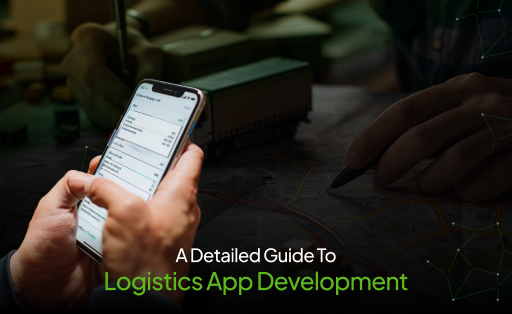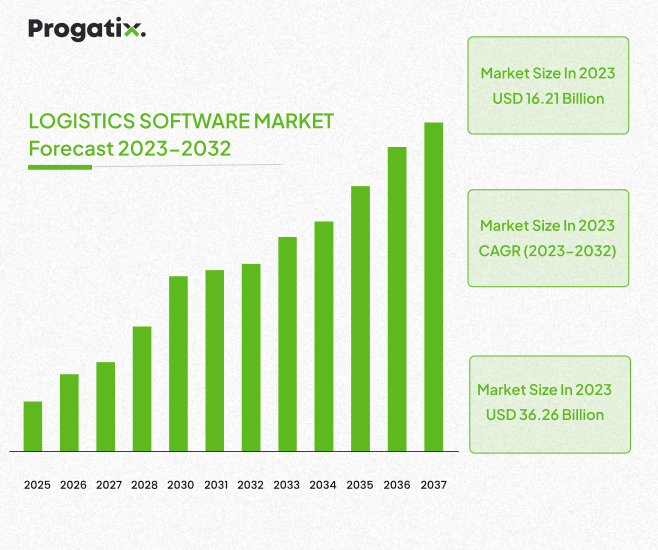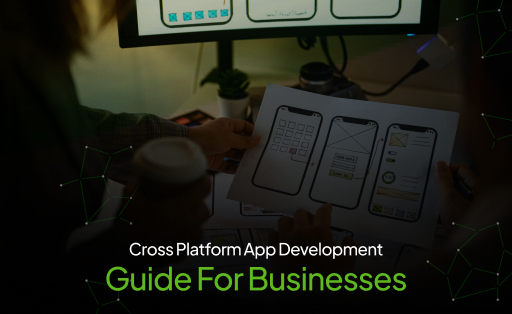A Detailed Guide To Logistics App Development App Development

Whether it is truck transportation, supply chain management, international transportation, or more, such subsets of the logistics industry face a lack of supply chain transparency, route optimization, data management, and more.
The final solution to all these hurdles is Logistics software development. Implementing technology allows businesses to get the benefits of innovative tech such as AI, IoT, blockchain, big data and more. Though when adopting digital solutions similar to these, the business owners are usually unwilling and frightened, expecting its influence on their business.
For more in-depth information regarding the future of logistics app development, continue reading this blog.
Let’s start with the basics.
Logistics Apps Development- A Brief Outline
Logistics app development comprises mobile or web app development for tablets, computers, and phones, helping businesses manage and organize the goods and transportation flows more effectively. Such apps are designed to simplify, track, and handle the intricate flow of goods from one location to another. These apps could integrate smoothly with the present logistics infrastructure and assist businesses at every stage of transportation. From inventory management and order placement to route optimization, communication, payments, and tracking, they offer businesses integrated solutions for the automation of the whole workflow. By closing the gap between physical logistics networks and the digital interface, logistics app development strengthens businesses’ ability to function in the dynamic world of transportation quickly and proficiently.
Logistics App Market Size
The global logistics software market size was estimated at USD 16.21 billion in 2023. It is anticipated to reach from USD 17.72 billion in 2024 to USD 36.26 billion by 2032, increasing at a CAGR of 9.36% during the forecast period (2024–2032).
Types of Logistics Apps
Transportation, inventory, warehousing, and truck management are all included in the logistics area; each has specific requirements. Therefore, the broad range of transport and logistics apps is not surprising. Therefore, choosing the app type is crucial before diving into the specifics of developing a custom logistics mobile app. We’ve selected the most popular types to make matters easier for you.
-
Fleet Management Apps
Without your fleet, you simply would not be able to convey your assets from one point to another, which will put your entire business on hold.
A fleet management solution will assist you in taking care of the vehicles. Irrespective of how wide your fleet is, this app will gather, manage, and keep all the information regarding your trucks, which includes their maintenance history, which is crucial for timely maintenance or spare. Few transportation management apps also collect data regarding costs to assist you in evaluating the complete ownership expenses, sharing maintenance notifications, creating reports, and more. As an outcome, you keep your vehicle running easily in a cost-effective manner.
-
On-Demand Logistics Apps
If your trucks are not completely loaded, it’s possibly an ideal opportunity to develop an additional source of income with an on-demand logistics app.
Here is how they function:
- A shipper adds a request.
- The nearest available driver with additional space in their truck gets the notification, agrees to the requests, and picks up the shipping.
- The shipper tracks the cargo’s location and receives alerts about the shipment status.
- Once the shipping is done, the system sends an invoice to the shipper.
-
Real-Time Tracking Apps
As the name sounds, such apps help you stay up to date regarding your shipments, vehicles, and drivers at all times, both domestically and globally. It tracks trucks’ whereabouts in real-time and shares updates on the deliveries, routes, and locations with the users.
-
Warehouse and Inventory Management Apps
A warehouse and inventory management app assists you in ensuring that all your shipments will reach their destinations at the right time. These apps are very identical to real-time tracking solutions. But there is a major difference between the two. Warehousing apps emphasize particularly on warehouse owners, whereas real-time tracking tools have a wide range of audiences.
Usually equipped with barcode scanning technologies, warehouse management apps assist you in managing and tracking the status of hundreds of deliveries. The best offerings even involve internal databases to make real-time updates, thus decreasing manual input and, as a result, leading to human error.
-
Delivery Apps
Delivery apps are made to help with delivering goods from one location to another. The key reason is to engage businesses with customers seeking for their products via a network of couriers. Clients can select between on-demand (immediate delivery) or scheduled (delivery for a specific date and time) opportunities.
Such apps enable customers to track orders in real-time and offer numerous payment options, including mobile banking, credit card, and cash. Businesses can offer rapid and easy delivery, resulting in improved customer service while clients manage the whole process.
A logistics application can undoubtedly bring significant value to a business and a wrong approach to its development can waste your budget. This rule applies to all kinds of apps.
How Does a Logistics App Work?
All things considered, a logistics app is a complete solution that maximizes the flow of goods, improves supply chain visibility and enables efficient stakeholder communication.
Essentially, the logistics software transforms manual chores into effective, automated operations by combining several logistics chain components. Order placement is usually the first step in the process, during which the app gathers data about the items that need to be shipped. The logistics network then smoothly processes this data, including activities such as shipment tracking, inventory management, and route optimization, among others.
By combining these elements, a logistics app essentially serves as a digital command hub that maximizes the flow of products from the beginning to the conclusion.
Key Features of a Logistics App
The key or crucial features of a logistics app are made to cover a wide variety of tasks and workflows regarding order management, shipping, real-time movement of goods monitoring, route planning, transaction tracking, document management, warehouse management, inventory control, reporting, customer portal, and payments. Here are a few must-have features you must include during Logistics app development.
-
Real-Time Shipment Tracking
This feature offers real-time transparency into the status and location of shipments, enabling users to track deliveries from pickup to delivery.
-
Route Optimization
Optimizes delivery routes as per distance, traffic conditions, and delivery schedules to lessen fuel costs and delivery times.
-
Inventory Management
This allows the effective management of inventory levels, stock tracking, warehouse organization, and inventory replacement.
-
Order Management
This position simplifies the processing and management of orders, including order placement, order tracking, and order fulfillment.
-
Fleet Management
This position effectively manages vehicle fleets, including vehicle tracking, driver assignment, maintenance scheduling, and fuel management.
-
Compliance and Documentation Management
Guarantees agreement to regulatory requirements and manages documentation i.e., shipping lists, customs forms, and delivery receipts.
-
Electronic Proof of Delivery (ePOD)
Enable drivers to seize electronic signatures, photos, and notes on delivery, offering proof of delivery and guaranteeing answerability.
-
Barcode Scanning and RFID Integration
Barcode scanning and RFID technology simplify inventory management and order processing, enabling precise goods tracking.
-
Performance Analytics and Reporting
Offers insights into key performance metrics, including delivery times, fleet utilization, and inventory turnover, via analytics dashboards and personalized reports.
-
Integration with Third-Party Services
Integrates with third-party services, including GPS tracking, mapping APIs, payment gateways, and ERP systems, to improve functionality and data exchange.
-
Communication Tools
In-app messaging, notifications, and alerts enable smooth communication among drivers, dispatchers, and customers.
-
Customer Portal or Self-Service Tools
Strengthen customers to track shipments, place orders, and manage deliveries via a user-friendly customer portal or self-service tools.
-
Scalability and Customization
This service provides scalability and personalization options to lodge the exclusive requirements and growth of businesses of all sizes.
-
Security and Data Protection
Execute robust security measures to secure sensitive data such as customer details, transaction records, and intellectual property.
-
Offline Capabilities
Offers offline competencies for vital functions such as data gathering, route planning, and order processing, confirming steadiness of operations in areas with restricted connectivity.
Build a Powerful Logistics App with Experts!
Let's ConnectWhat Are the Main Challenges in Logistics App Development?
In addition to the difficulties logistics business owners encounter in running their operations, driven by non-traditional methods, their development companion could face certain challenges. During the app development process, these companies might encounter the following significant challenges:
-
Data Security and Restrictions
With a logistics app development, there is sensitive data such as user information that the business owners need to offer an engaging user experience in the logistics app. The huge challenge for a logistics app development company is the security of data from cybercriminals, aka hackers.
In a few locations/countries, there are particular limitations in collecting data, such as GPS data. This would only make the development challenges more extreme as the development solution needs to be customized, ensuring it functions smoothly irrespective of such geographical limitations.
-
Selecting the Right Feature Set
You do not want an app development that is already provided by your competitors or that is not required by your target audience. Providing features that cater to the industry requirements and simplify operational efficiency while delivering valuable unique selling points (USPS).
Creating a minimum viable product (MVP) with a few essential features is the easiest way to get beyond this challenge. After that, expand on your MVP using user suggestions and comments as well as the features you’ve decided are essential based on market research.
-
Opting for the Right Tech Stack
The best tech stack for custom logistics software guarantees strength, high performance, scalability, and flexibility. It aligns with the app’s vision, satisfies architectural requirements, and keeps potential constraints, allowing efficient and adaptable development. It also addresses features such as community support, development speed, and the capability to put up future advancements.
Why is logistics app development essential for Transportation Businesses?
A logistics app is more than merely a technical improvement; it’s a game-changing software that will entirely transform how your logistics and transportation services are delivered and employed. A well-designed logistics app becomes vital for business expansion as technology develops.
The increasing interest in more efficient operations, better client experiences, and simplified procedures make it essential. Custom logistics software will provide your company with the following notable advantages:
- Tracking and visibility in real-time
- Smooth coordination
- Analytics and insights from data
- Supply chain optimization
- Automate more, minimize paper
- Lower expenses and energy
- Fast and precise processing
- Effective fleet administration
- Managing warehouses efficiently
- Adherence to regulations
- Online reservations
- Increased productivity
Steps Involved in the Development of a Logistics App
A custom logistics app development is a complex task integrating a complex development process from ideation to conceptualizing the idea, and designing, deploying and maintaining the software solution after the deployment.
Here is a comprehensive development process that developers can consider when building a logistics app:
-
Define Your Unique Selling Proposition (USP)
A value-driven service is vital to gain customer trust. This is only possible when the logistics business understands what service it wants to deliver to its stakeholders or user personas. Defining goals allows businesses to brainstorm and come up with user-centered USPs that would offer value service to their end-user when utilizing their logistics app.
Start by selecting the type of logistics app that aligns perfectly with your business goals. Identify the functionalities and features you imagine for your logistics app, assuring that each step aligns with your end goals. Upon doing that, it is time to gain competitive intelligence to make sure that you have a knowledge of what it would take to stay ahead of the competition.
-
Hire a Logistics App Development Company
Now that you have smartly chosen to have a logistics app for your business, it is time to smartly hire a logistics app development company. These professionals and skilled companies bring extensive expertise, guiding you through the whole process of building a high-quality logistics app.
From conceptualizing to deployment, their committed teams or app developers for hiring work collaboratively with you to comprehend your unique needs and offer a personalized solution.
-
Building the Technology Foundation
This would build the foundation of your app, specifying the technology needs and infrastructure considerations, ensuring your app’s smooth performance, scalability, and adaptability. From selecting the right programming languages to building a strong server architecture, this part sets the stage for a successful logistics app development.
This is what an ideal tech stack of a logistics app looks like:
Once you have defined the tech stack, it’s time to work on your logistics app’s aesthetics.
-
Developing Intuitive Interfaces
Simply having smooth functionality would not fulfill the need for an aesthetically engaging logistics app. From effortless navigation to appealing appearance, including how it feels when utilized, how it appears, and more, designing the UI/UX addresses the visual factors of logistics software.
The UI/UX designers for hire have to address each design detail, from intuitive navigation menus to clear detail hierarchy; each element adds up to the efficiency and user engagement of the logistics app.
-
Developing Key Features and Functionality
Once you have each prerequisite aspect of logistic app development, it is time to get to code such features and functionalities. One of the most costly yet cost-efficient approaches to start the development process is the development of an MVP.
You can hire a skilled developer’s team for working concurrently on every panel which includes panel, driver/dispatcher, and admin) to accelerate the development process, eliminating the time to market.
-
Quality Assurance
Every build of the logistics app development has to undergo a thorough assessment by the hired quality assurance professionals to find any bugs or glitches in the app’s security, performance, and function.
The goal is to ensure that every feature of an app, from user interface to backend functionalities, functions smoothly and effectively to make sure that the logistics app caters to the highest standards before it reaches the end users.
-
Deployment and Maintenance
The time has come for potential customers to engage with an MVP. It’s time to release the already installed software on the preferred platforms, whether it’s a website or an application. The app must be built by the developers to comply with certain requirements before deployment in order to guarantee compatibility with a range of devices and a smooth integration with current systems.
Deploying the build on these platforms is not the end of the process; ongoing monitoring and updating are required to maintain the software’s functionality, performance, integration of new features, and other aspects. This is to make sure your program fulfills the logistics industry’s constantly shifting requirements.
The Cost of Building a Logistics App
The cost of Logistics mobile app development depends on wide-ranging factors, i.e., app features and complexities, development team size, the choice of platform, tech stack, and so on. Every logistics app contains several functions, third-party tools, and features. So, it is challenging to regulate the cost of a logistics mobile app development. However, here is an approximate estimate of a Logistics app development cost for you by assessing the factors impacting its development cost.
App Features and Complexities
Basic
Includes simple features like real-time tracking, order management, and basic driver functionalities.
- Platform
iOS/Android/Hybrid
- Estimated Price Range
$20,000 – $50,000
Medium
It also includes extra features such as route optimization, inventory management, ePOD (electronic proof of delivery), and communication tools.
- Platform
iOS/Android/Hybrid
- Estimated Price Range
$50,000 – $100,000
Advanced
It includes complex features such as AI-powered route optimization, real-time traffic integration, advanced analytics, and third-party integrations.
- Platform
iOS/Android/Hybrid
- Estimated Price Range
$100,000+
Development Team Size
Small Team (2-3 Developers)
Slower development time with potentially higher hourly rates.
- Cost
Varies based on hourly rates and project scope.
Medium Team (4-6 Developers)
Faster development with potentially lower hourly rates due to team efficiency.
- Cost
Varies based on hourly rates and project scope.
Large Team (7+ Developers)
Fastest development with potentially lower overall cost due to economies of scale.
- Cost
Varies based on hourly rates and project scope.
Choice of Platform
Native Development (iOS & Android)
Higher development cost due to separate codebases for iOS and Android.
- Estimated Price Range
$20,000 – $50,000 per platform
Cross-Platform Development (React Native, Flutter)
Lower development cost due to code reusability across platforms.
- Estimated Price Range
$30,000 – $70,000
Hybrid Development (Ionic, Capacitor)
Moderate development cost with potentially faster development compared to native.
- Estimated Price Range
$25,000 – $60,000
Tech Stack
Popular Languages (Python, Node.js, Java)
Lower development cost due to the availability of developers.
- Cost
Varies based on developer skills and project needs.
Less Common Languages (Go, Ruby)
Higher development cost due to a limited developer pool.
- Cost
Varies based on developer expertise and project requirements.
To Conclude,
A custom logistics app can offer several advantages, including real-time tracking, route optimization, inventory management, and automated dispatching. They all assist businesses in lessening costs, enhance delivery times, and improve customer satisfaction. However, logistics app development also comes up with drawbacks and challenges, like security risks, data management issues, and technical difficulties.
When looking for logistics custom software, it is vital to select a skilled logistics app development company that comprehends the unique requirements of logistics operations. Contact Progatix to discuss your requirements and demands and find the right solution.
Get On-Demand Logistics Success with Progatix
Transform your vision into a progressive reality with Progatix, an expert partner for on-demand logistics app development, offering various logistics software development solutions. Whether you want to streamline supply chain management, improve real-time tracking, or integrate cutting-edge features, our on-demand logistics software services are tailored to your needs.
Progatix stands apart from the competition because of our dedication to remaining at the lead of industry trends. Our app developer for hire gives your logistics app unparalleled scalability and effectiveness by using the most recent developments in AI, IoT, blockchain, cloud computing, big data analytics, and more.
Getting in touch with Progatix is about forming a long-term collaboration rather than just developing an app. To keep your logistics app operating at its best, we offer regular maintenance, upgrades, and optimization.



 Let's Discuss Your Tech Solutions
Let's Discuss Your Tech Solutions 






